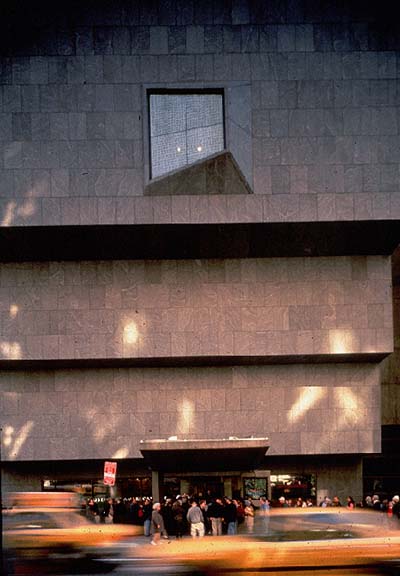
Were the Whitney Biennial an entry on the police blotter of art history, of the Who, What, When, Why, “Just the Facts, Ma’am” variety, then this short text concerns its Where. Unlike other New York museums, which have recently, for better or worse, completed dramatic new building projects (MoMA’s Tanaguchi temple and the New Museum’s grey ghost on the Bowery) or made major efforts in franchising their brand overseas (look no further than the Mc Guggenheims) the Whitney has generally been stymied in its expansion plans.
Despite a long history of attempts, including the Michael Graves postmodernist fiasco of 1985 and a Rem Koolhaas proposed tower that was scrapped in 2003, the museum has thus far been denied its grand gesture, and has only been able to complete useful but minimal initiatives, such as the incorporation of two adjacent brownstones for offices and other administrative functions. This stalemate might change with the construction of a Renzo Piano designed downtown branch abutting the High Line, where the Dia Foundation once planned to re-settle. But for the moment, the Whitney remains five floors of an inverted Marcel Breuer ziggurat on Madison Avenue and 74th Street, nestled into a 100 x 125 foot lot, surrounded by the decorous residential buildings and commercial glitz of the Upper East Side.

After many years attending shows, and not just Biennials, in this same landmark building, a sense of familiarity and trust develops. The museum’s physical plant has an obvious but reassuring constancy: the flagstone floors, the honeycombed ceilings. One remembers previous layouts and alternate selections of art, different walls for different sprawls, other work placed near the trapezoidal windows, other uses of the sunken courtyard, other displays in the glass case near the (woefully inadequate) second floor screening room. The Whitney’s “failure” to expand has, perhaps counter-intuitively, had a positive influence, engendering good will that might have been lessened or lost had the museum embarked on the same hubristic will to super size that enticed its sister institutions.
We enjoy the Whitney for its scrappy, resourceful independence, for managing to do a lot with a little. There is not just a legacy of excellent, well curated shows, which seem to place art first rather than running after blockbuster content (with the occasional lapse, like last summer’s psychedelic extravaganza) but also a modesty of scale and intention, as embodied in the clever, contained modernism of its 1966 Breuer building.

But if the Whitney does not chase after blockbusters, perhaps that’s because it doesn’t really need to. It has its own built-in blockbuster every two years, the Biennial, which in its self-appointed mission to select the best and brightest in American art is destined (some would say condemned) to be a periodic weathervane for controversy. How this plays out in general admissions over the course of the show is up for debate, but a Biennial media preview attracts about ten times the usual press. Writers from Fanciful Felines, to cite a fictitious magazine, come out of the woodwork, claiming they write about cats … and art. The entire press corps needs to view “the show that everyone loves to hate,” proving Schadenfreude is still a strong draw among the chattering classes.
Who can blame the museum for wanting to stretch out a bit at this time, at this moment of maximum visibility? Previous editions of the Biennial have incorporated outdoor sculpture in Central Park, projects at the zoo, pairings with the Public Art Fund. But this year, in a move that has been fully oversold in the media, almost as much as the exhibition’s clubby, “Facebook” aesthetic, the Whitney has expanded the Biennial’s first twenty days into a series of temporary installations, performances and parties at the Seventh Regiment Armory, the moldering Victorian pile seven blocks south of the museum. The same Armory that is host to various art fairs throughout the year and the occasional invitation-only, motorcycle-fueled performance piece replete with macho territoriality and carbon monoxide.

Occupying a full square block, with a central Drill Hall five stories high and an enclosed area better measured in acres than square feet, the Armory dwarfs the museum proper. It would seem to answer every artist’s secret wet dream: space, space, glorious space, in a city where real estate options for studios range from the challenging to the impossible. The Armory is built on a baronial scale, with charming anachronisms of nineteenth century architecture and ornamentation: dark wood paneling and wainscoting, elaborate arched transoms and doorways, chandeliers, wide halls, double staircases, glass enclosed cabinets full of silver cups and urns, long unused wooden lockers, military flags, bunting and portraiture, all the pomp and panoply of a forgotten era.
It is also falling apart. Its patched ceilings and walls, ancient electrical wiring and other building systems need replacement, and are slated for massive renovation, so that the Armory can become a more useful and attractive space for a full calendar of art projects. Once that occurs, one wonders what will happen to its current roster of temporary residents who occupy a women’s shelter housed on its third and fifth floors.

But in its current incarnation, still a bit dilapidated and physically distressed, the Armory feels like the anti-Whitney: dark, decaying, somber and old, decidedly not adhering to the usual exhibition model of a clean white cube. It resonates as a haunted house, a locus of the unconscious mind with creaky floors and untrammeled visions. Despite its address of Park Avenue and 67th Street, not exactly the poorest part of town, the Armory manages to recapitulate the history of artists as battering rams for real estate: moving into questionable neighborhoods and compromised buildings, into cold water tenement flats and windy industrial lofts, with leaks and holes and rotting fixtures, and making these places useful again, at first just for their creative enterprise, as reclaimed enclaves for the demimonde, but eventually “safe” for general use and for the enrichment of speculators.

The Armory, then, is not just extra space to house the Biennial. It connotes an entirely different sort of space. If the museum is the quintessential white box, where finished work winds up, where its importance and art historical value can be measured in a cool, clear, antiseptic light, then the Armory is emblematic of the studio, a place much closer to the actual moment of creation, more “honest”, more “immediate”, more revelatory of praxis. Also clubbier, more bohemian, fecund and feral: what Kurt Cobain was talking about in “Smells Like Teen Spirit”. A place where artists can engage in ephemeral acts, where they can feel unhampered, where they can fail and try again, where they can cavort and play as we, lucky mortals, watch them do so. A place to see the art before it is complete, perhaps before it has even been imagined. A funky incubator.
It hardly matters whether an installation at the Armory is any less studied or self conscious than similar work at the Whitney proper. The pose is all. The iconography of the Armory as a venue is part Masonic Temple and part outer borough rock club. Its casual, transitory aspect, its feeling of being unfinished and unpredictable, awash and unmoored in history, makes it the symbolic center of the larger exhibition, and gives visual proof to Henriette Huldisch and Shamim Momim’s “embrace of locality”, to their tireless globe hopping, their search for the hippest, most cutting edge work in this “you had to be there” Biennial.

the armory is where its at
I just got back from Europe and missed most of the Armory. I just saw the Biennial today. Saw the Omar Fast piece at the centre pompidou in Paris. I saw it again at the Whitney. It's brilliant! I've been exploring similar assembled stories in my "assembled Cinema Piece;
http://nujus.net/gh_04/gallery11.html
Also memorable was Karen Kliminick, and Walead Beshty as well as the Jason Rhoades and Spike Lee's film about New Orleans. Anyway, seems like the energy and inventiveness is going on at the armory.
http://nujus.net/gh